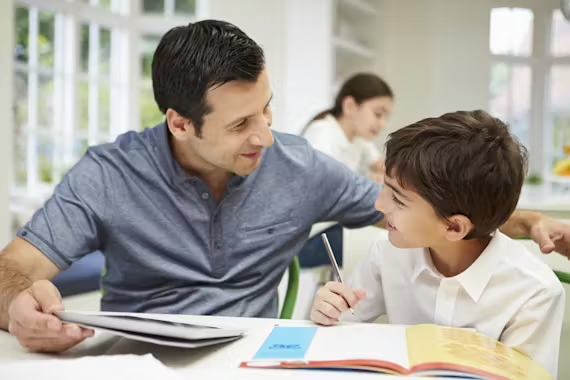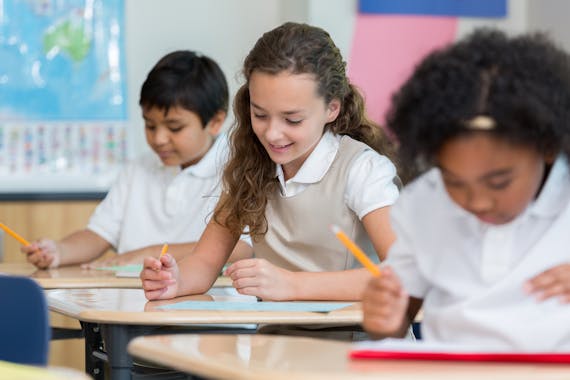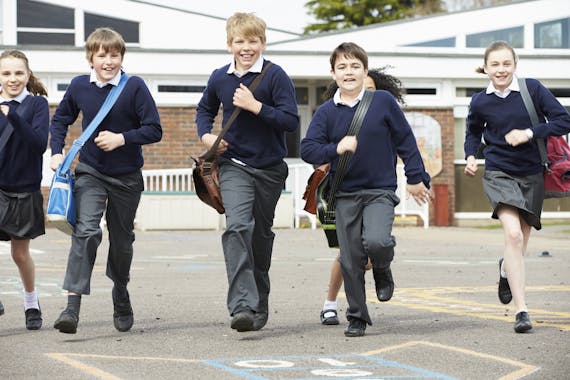Expected Standard
Children in Year 6 take their KS2 SATs exams in May. These primary school tests (together with teacher assessments) will judge whether they have met the 'expected standard' when they leave primary school.

So what exactly is the 'expected standard'?
Here we will explain what constitutes the 'expected standard' and explain what knowledge and skills your child must demonstrate to achieve it.
Table of Contents
What is the Expected Standard?
The 'expected standard' is a term used to describe the academic knowledge and skills deemed 'expected' for all children leaving primary school.
How is the expected standard calculated?
The expected standard corresponds to a particular scaled score - 100.
Scaled Score & Raw Score
When Key Stage 2 SATs exams are marked, children's exam marks are added up as a 'raw score' (e.g. 58/70). After a complex moderation process a child's raw score is converted into a 'scaled score' between 80 and 120.

If your child's scaled score is 100 or more then they have achieved the expected standard.
Highest scaled score and lowest scaled score
The highest scaled score is 120. These children have exceeded the expected standard.
The lowest scaled score a child can be awarded is 80. These children have not met the expected standard and they are hence classified as 'working towards' the expected standard.
Raw/Scaled Score Conversion Tabels
Each year, a table is generated by the STA that shows the raw score marks needed for achieving the expected standard, allowing schools to check whether a child is working at the expected standard.

For more information about scaled scores and marking SATs in general, see our dedicated SATs Scores Explained article.
Scaled Scores or National Curriculum Levels?
Until 2015, primary schools and secondary schools used national curriculum levels to judge children's academic abilities. Primary schools no longer use level assessed methods to score SATs papers, it's now 'scaled scores'.
Why is the expected standard used?
Converting raw scores into scaled scores allows each year's SATs results to be easily and quickly compared with previous years. Thus the progress of individual pupils and schools can be monitored.
KS2 SATs School Performance Tables
The scores for each school are made public and used to create school performance tables (also known as school league tables) which parents can look at when choosing a suitable school for their children. However, it is worth mentioning that individual children's results are not made public.
Who sets the expected standard, and how?
The government's Standards and Testing Agency (STA) set the raw marks required for the 'expected standard' via their aforementioned 'moderation process'.
A moderation process is required because different test papers need different questions and some tests may be deemed more or less challenging than in previous years.

Once all Key Stage 2 SATs papers are marked, all raw score data is collected and analysed. The STA then use this data to help determine the number of 'raw' marks needed to achieve the various scaled scores. Finally, the conversion details are sent to schools, which offer an easy conversion of children's raw scores to scaled scores.
The standardised scores for Key Stage 2 SATs from 2016 through 2022 are public and are available to view online.
What level of work represents the 'expected standard'?
Explaining whether a child has met the expected standard via quantified marks is easy - we just need to add up the marks and check the raw score to scaled score conversion tables.

What's much harder is explaining to parents what the expected standard looks like in terms of your child's work and what they are expected to do*! So, here we go...
English Reading
The KS2 SATs reading paper is a comprehension test that consists of three different texts, with sets of questions specific to each text. Children have 60 minutes to read the texts and answer all the questions. This assessment is marked externally.

To achieve the expected standard in this reading comprehension test, your child needs to answer the questions and show that they can:
Retrieve specific information, whether it is stated or implied within the text.
Order the events from a text, such as numbering statements from 1-5 as they appear in the text.
Understand the meaning of certain words used in the text and identify another word that could replace it.
Infer information about a character's feelings, thoughts or motives and justify their inferences with evidence from the text.
Summarise the main idea of the whole or part of a text.
Distinguish between facts and opinions.
Explain the impact of the author's language or text structure on the reader. For example, they may be asked why an author has used figurative language and what it makes the reader think about or how it makes them feel and why.
Make predictions based on what they have read and offer evidence from the text to support their prediction.
Make comparisons between characters, settings or themes that run throughout a text, such as explaining how a character's feelings or emotions change throughout the text and being able to offer evidence from the text to support their comparisons.
English Writing
There is no formal KS2 SATs writing exam. Instead, teachers craft and set their own internal tests called 'teacher assessments'. These are then marked within school and the teacher assessment results are submitted to the STA for moderation.
With the writing assessment being much more subjective than other assessments, teachers design their tests in a fair, structed manner such that children earn more marks for demonstrating more skills and/or skills at a greater depth.

To achieve the expected standard in writing, children need to have shown that they can:
Write legibly in 'joined up' writing, i.e. their handwriting needs to be clear and easy to read.
Use a range of punctuation consistently and correctly, e.g. capital letters, full stops, apostrophes, commas, colons, and inverted commas (speech marks).
Spell most words from the KS2 word lists correctly and use a dictionary to check the spelling of more ambitious vocabulary.
Write effectively for a range of purposes and audiences, i.e. writing in the first person for a diary, using imperative verbs and organisational structures in instructions and using persuasive language techniques.
Choose vocabulary and grammatical structures that are suitable for their writing, i.e., using informal and contracted vocabulary in dialogue and modal verbs to indicate likelihood.
Describe settings, characters, and atmosphere when writing stories.
Include dialogue (speech) in their writing and use it to move the story forward or to show a character's personality.
Use verb tenses correctly and consistently.
Use a range of 'cohesive devices', i.e. They can make their writing flow and progress in and across paragraphs by using different conjunctions, adverbials, pronouns, and synonyms.
With the KS2 Writing assessments being less structured than the others, the onus is on children to demonstrate the range of skills listed above rather than relying on the questions. I.e. it's not enough to simply 'get everything right' or 'not making any mistakes' - kids need to show it.
Grammar, Punctuation and Spelling
For grammar, punctuation and spelling, children complete a 20-word spelling paper and a separate short-answer punctuation and grammar paper. This assessment is marked externally.

To achieve the expected standard, your child needs to have demonstrated that they can:
Spell a range of words from the KS2 Spelling list with a variety of spelling patterns such as the suffixes -tious/-cious, -tion/-cian, and -able/-ible.
Spell a greater variety of words (i.e. common words outside of the KS2 Spelling list) with various prefixes and suffixes such as im-, il, ir, pre, etc.
Accurately select and spell words which are homophones or near homophones.
Select and identify different word types, such as verbs, adverbs, adjectives, nouns, and pronouns, including possessive and relative pronouns, determiners, conjunctions and prepositions.
Identify different functions of sentences, i.e., statements, questions, commands and exclamations, and how they should be punctuated.
Identify the subject and object of a sentence.
Match or select suitable prefixes and suffixes for given words.
Select suitable punctuation for a given sentence, including capital letters, full stops, question marks, exclamation marks, commas (for various functions), inverted commas, apostrophes, parenthesis, colons, semicolons, dashes, hyphens and bullet points.
Understand and identify different sentence structures, including main and subordinate clauses, relative clauses, adverbial phrases and fronted adverbials.
Determine when to use coordinating or subordinating conjunctions and understand the difference in sentence structure.
Identify and suggest synonyms and antonyms.
Identify root words in word families.
Identify when standard English or non-standard English has been used in a sentence.
Understand the difference between formal and informal vocabulary and know when each should be used.
Maths
There are three separate KS2 SATs maths assessments: mental arithmetic, reasoning paper 1 and reasoning paper 2. This assessment is marked externally.
Over the three exams, children are tested on numerous mathematical topics, including number and place value; addition, subtraction, multiplication and division; fractions, decimals and percentages; measurement; geometry; statistics; ratio and proportion; and algebra.

To achieve the expected standard, your child needs to have demonstrated that they can:
Read, write, order, compare and understand place value in numbers up to 10,000,000, including numbers with up to 3 decimal places.
Round a given number to the nearest 10, 100, 1000, 10,000 etc.
Use and perform calculations with negative numbers.
Perform mental calculations and solve problems involving one or more operations, i.e., addition, subtraction, multiplication and division.
Use the correct order of operations when solving problems with more than one operation (i.e. BODMAS or 'BIDMAS').
Estimate and check answers to calculations.
Multiply and divide large numbers mentally.
Multiply and divide 4-digit numbers by 2-digit numbers using a variety of formal methods (e.g. long-multiplication or short-division) and identify and record any remainders accurately according to the context of the question.
Identify common factors and multiples of numbers.
Understand the concept of and identify equivalent fractions.
Use their knowledge of common multiples and factors to simplify or express fractions in the same denomination.
Compare and order fractions, including mixed-number and improper fractions.
Add and subtract fractions with different denominators.
Multiply pairs of simple fractions.
Divide fractions by whole numbers.
Calculate fraction, decimal and percentage equivalents.
Multiply 1-digit numbers with up to two decimal places by whole numbers.
Solve problems which include dividing numbers with up to two decimal places and rounding answers to a given degree of accuracy.
Use, read, understand and convert between different units of measurement, i.e., metres to kilometres.
Solve problems and record answers using appropriate units of measurement, including mm, cm, m and km; seconds, minutes and hours; ml, cl and l etc.
Convert distances between miles and kilometres.
Calculate the perimeter and area of shapes, including triangles, rectangles and parallelograms and recognise that shapes with the same area can have different perimeters.
Use a given formula to help solve problems involving the area of a shape.
Calculate, estimate and compare the volume of cubes and cuboids and record answers using the correct units, i.e., cm3.
Draw 2D shapes using given angles and dimensions.
Recognise and describe the properties of 3D shapes and identify or create nets to build a given shape.
Compare and classify shapes.
Find missing angles of shapes, including triangles, quadrilaterals and regular polygons.
Name the parts of a circle, including the circumference, diameter and radius and recognise that the diameter is twice the radius.
Recognise and measure angles where they meet at a point and angles on a straight line.
Calculate any missing angles using the understanding that a straight line is 180o.
Describe the position of a shape or point using coordinates.
Translate and reflect simple shapes on a coordinate plane.
Construct and interpret information in charts such as pie charts and line graphs.
Calculate the mean as an average from a given set of data.
Solve problems relating to size or quantities by finding missing values through multiplication and division.
Solve problems which involve calculating a percentage of a number.
Use scale factors to solve problems involving shape.
Use simple algebraic formulae and find missing values.
Describe and generate linear number sequences and find missing values.
Find pairs of numbers to satisfy an equation with two unknown numbers.
(It is worth noting that to access much of the mathematics papers, your child will need a solid understanding of addition, subtraction, multiplication and division since these functions are the basis of everything else.)
Average Expected Standard
While the scaled scores required to achieve the expected standard are recalculated every year, it is possible to create an 'average expected standard score'.

This could be useful for teachers, parents and pupils that want to target a particular raw score in their SATs preparation.
| Subject | Raw Marks required for Expected Standard |
|---|---|
| GaPS | 37 |
| Maths | 57 |
| English | 26 |
This average expected standard score has been calculated using the 2016, 2017, 2018, 2019 and 2022 KS2 SATs scores. We have created this for each SATs exam and they can be found in the table below:
FAQ
Who sets the 'expected standard' for KS2 SATs?
The expected standard is set by the government's Standards and Testing Agency (STA). The raw scores required to achieve a scaled score of 100 change slightly each year in line with the difficulty of the tests and the number of marks available for each exam.
What does my child need to be able to do to achieve the expected standard for KS2 SATs?
Your child must demonstrate a wide range of knowledge and skills for reading, writing, spelling, punctuation and grammar, and mathematics. These specific skills are discussed in the article above.
What happens if my child does not achieve the 'expected standard'?
Your child's teacher will look at areas where your child may benefit from extra support and share this information with your chosen secondary school.
Did the Expected standard for KS2 SATs change in 2024?
No, although overall results indicated a slight drop in the number of pupils achieving the expected standard in spelling, punctuation and grammar, and mathematics.
*(Please remember that every child is different, and what comes naturally for one child may seem impossible for another. It is important to consider what a 'good score' would be for your child as an individual rather than trying to set unattainable goals. Take into consideration that your child cannot fail SATs. A child who does not meet the 'expected standard' will likely receive more support in secondary school.)
